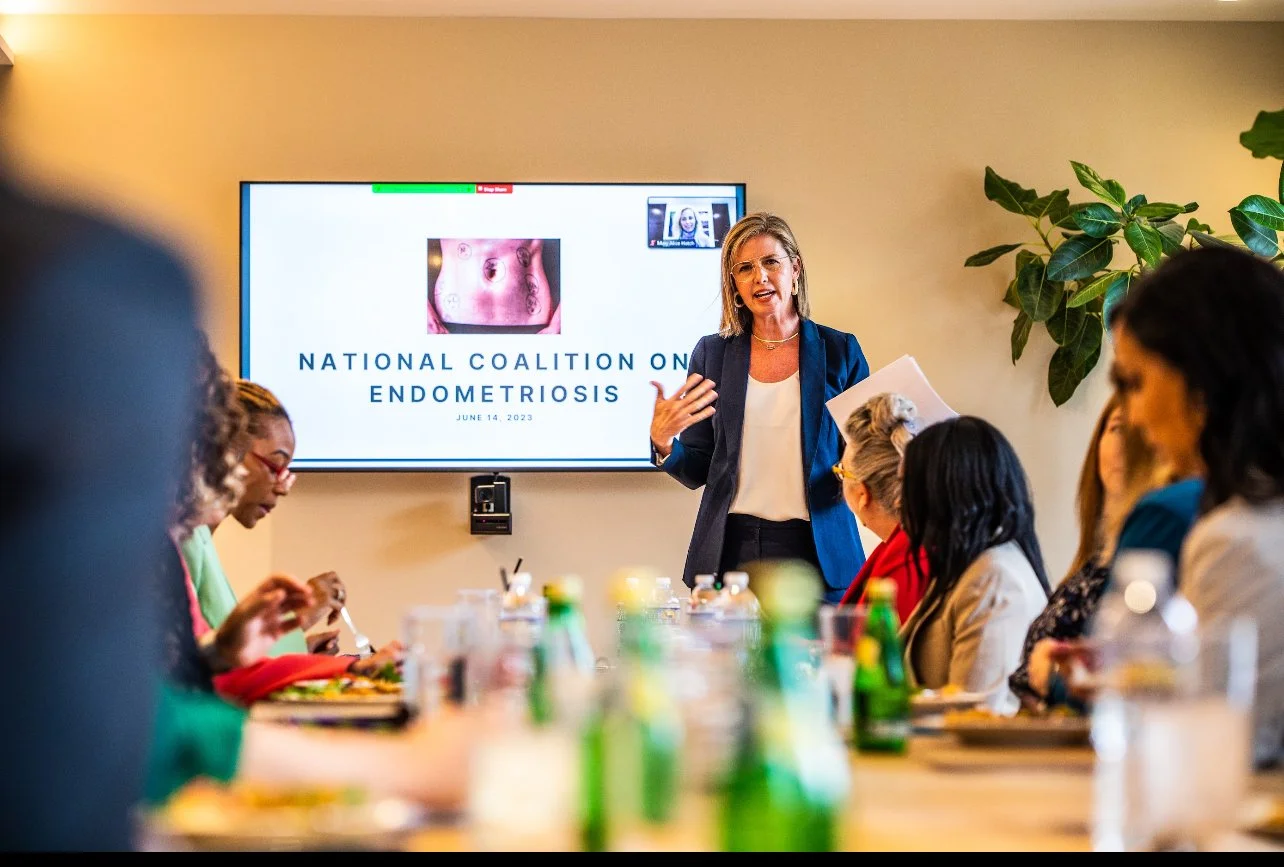Jenneh Rishe, RN, (top) co-founder of The Endometriosis Coalition and Rachel Vogelstein (bottom) of the White House Gender Policy Council speak at a special roundtable meeting in Washington D.C.
National Endometriosis Task Force
The goal of the Task Force is to facilitate a real & enduring improvement in the quality of life for individuals with endometriosis and decrease the disease’s burden at the personal and societal levels.
The Task Force brings together patient advocates, providers, NIH Directors, members of the White House Gender Policy Council and Congressional members from both political parties to address the physical, financial, mental, emotional and social impacts of endometriosis.
Shannon Cohn, (top) Project Endo Director and Dr. Janine Clayton (bottom) Director of NIH Office of Research on Women’s Health.
FAQs
-
Virtually every person knows and loves someone with endometriosis. Endometriosis has been historically under-recognized among both the medical community and the public, and subsequently under-diagnosed. The average diagnostic delay is 7-10 years. The delay increases symptom severity, infertility rates and the personal and societal impact of the disease. The disease represents a perfect awful storm of so many things - stigma and menstrual taboo, gender bias, racial bias, financial barriers to good healthcare and so much more.
Investment in endometriosis will benefit all affected individuals and improve earlier diagnosis, multi-disciplinary treatment options and increased research funding that will be a game-changer in the narrative of this disease.
According to a recent report, endometriosis patients in the US spend $26,305 USD more than average on healthcare expenses in the 5 years before and after diagnosis. In the year after diagnosis patients with endometriosis spend on 3.5 times more on healthcare than the average person. Direct costs include in- and out-patient treatment, surgery, and prescription costs, which in the US average $12,118 per patient, per year. Indirect costs, including days of work lost and reduced quality of work, are almost $16,000 per patient per year.
Investment will benefit the general public, with a reduction in the overall burden of disease, through lower healthcare costs, reduced presenteeism/absenteeism rates, and increased social and economic participation. The total US endometriosis economic burden is estimated to be as high as $78–119 billion annually.
With dramatically increased funding directed towards research, both prevention and a cure for endometriosis may be achievable.
-
There are 3 priorities that identify the actions that will deliver a multipronged approach to endometriosis in the United States. Each of these priorities contribute towards the overall goal and objectives of the National Action Plan.
1. Accurate Awareness and Education
2. Patient Access to Benefits and Quality Treatments
3. Research
-
Stronger awareness and education of endometriosis are the foundation to improve diagnosis and care. Widespread awareness is the first step to reducing diagnostic delay. Education, particularly among those directly at risk of developing endometriosis and among health professionals, is fundamental for breaking the cycle of delayed diagnosis.
1. Create a National Action Plan on endometriosis
Creation of a public-private initiative to address the public health issue of endometriosis. As with the HIV/AIDS and Breast Cancer communities, endometriosis patient advocates are integral when making policy and decisions regarding their community and wellbeing.
We must create a participatory dialogue among patients, researchers, policymakers and other stakeholders who work together towards solutions. This would include, but not be limited to including patients and advocates when making decisions within the federal and state government, the Department of Health and Human Services, AMA, the NIH and the CDC among others. Beyond the health sector, it would also be important to include the Dept. of Education.
This includes the formation of a National Task Force on Endometriosis whose main objective is the execution of the Action Items, which starts here today.
2. A large scale, multi-prong health education campaign
A national health education campaign sufficiently nuanced to make the greatest impact, with specific initiatives to combat and hold to account the vast and pervasive endometriosis misinformation in the media, on the Internet, in clinical and other health sources, and to educate:
The public with specific emphasis on adolescents, reproductive-aged, and under-resourced populations, all of whom are subjected to additional health disparities and even longer delays in diagnosis than the average of 10 years,
Health care providers including but not limited to pediatricians, school nurses,OBGYNs, emergency medicine providers, general practitioners, medical students, and sub-specialists through educational offerings of not less than two contact hours annually and which include dissemination of self-screening tools and education kits in the clinical setting,
Adult mentors (e.g. teachers, coaches, community leaders) and other caregivers, including the dissemination of screening and education kits in the school setting in partnership with school nurses.
-
Improved patient access to benefits and multi-disciplinary care including excision surgery is pivotal to improving everyday lives and outcomes for patients with endometriosis. It’s our goal to:
Decrease barriers for endometriosis patients to attain disability benefits and accommodations under the Americans with Disabilities Act. To include but not be limited to federal, state, local and employer benefits.
Expand fundamental components of effective management and reduction of costs by improving access to treatment and standardization of evidence-based, multidisciplinary care.
Due to complications within the structure of payer plans vis a vis coding and reimbursement, many endometriosis specialists remain out of network providers, making care unattainable. Complex excision surgery is reimbursed by insurance companies at lower or same rate as ablation or not at all. Excision surgery needs separate CPT coding secondary to formal recognition and accreditation of the specialty of endometriosis care in the same manner urology, oncology and other disciplines are subject to/benefit from.
Provide low-income, uninsured, and underserved patients access to timely screening and affordable treatment options, including oral contraceptives, pain management, and high quality excision surgery,
Ensure that an endometriosis diagnosis does not disqualify patients from being covered under health insurance plans,
Develop standardized training modules with requisite certifications for all practitioners using the most current, evidence-based literature that reflects the systemic, inflammatory nature of the disease, incorporates the correct definition and expands the dialogue outside the current menstrual- and fertility-oriented language,
Implement requisite and timely referrals to endometriosis specialists for expert excision and multidisciplinary care of patients.
Ensure endometriosis patients have the same access to fertility benefits and preservation as cancer patients.
-
Endometriosis research remains seriously underfunded. As a result, current research efforts are largely redundant in nature and often lacking in translational benefit. Furthermore, many of the studies underway are directed solely towards pharmaceutical management and do not provide long-term solutions.Increased funding and support spread across emerging researchers and scientists can pave the way toward new breakthroughs.
According to a recent report:
“[t]he National Institutes of Health (NIH) is the largest source of biomedical research funding globally, allocating $41.7 billion USD annually. In 2022, the expected funding allocation for endometriosis is $16 million, 0.038% of the budget. Since the conservative estimate is that endometriosis affects 11% of US women in their lifetime, only $2.00 per patient per year is allocated. As a comparison, 12% of US women are expected to suffer from diabetes in their lifetime. If it is assumed that half of the allocated diabetes research budget was for female sufferers, there is a funding allocation of $31.30 per woman, over 1,500% more than for endometriosis.
Crohn's disease, like endometriosis, is a chronic inflammatory condition. There are over 690,000 people with Crohn's disease in the US, or 0.21% of the population. In 2022, Crohn's disease research will receive $90 million in funding, $130.07 per patient, over 65 times more per patient than for endometriosis. This comparison is not to suggest Crohn's disease is overfunded, but that endometriosis is seriously underfunded.
If endometriosis was funded by the NIH at half the level of diabetes, the budget would increase almost 16 times to over $250.4 million annually. Present levels of endometriosis funding do not reflect the immense pain of patients, long delays in diagnosis, the ineffectiveness of common treatment options, massive knowledge gaps, substantial economic burdens or the immense costs borne by individual patients.”
SOURCE: Ellis K, Munro D, Clarke J. Endometriosis Is Undervalued: A Call to Action. Front Glob Womens Health. 2022 May 10;3:902371.
-
A robust research agenda must be created to work urgently on:
(1) better clarifying disease pathogenesis - how endometriosis begins and develops including but not limited to specific research on the lesions vs. just native endometrium, menstrual effluent and similar, to lead to possible prevention and ultimately, one day, curative measures,
(2) improved and adaptable non-invasive diagnostic tools,
(3) exploring the links between endometriosis and various comorbidities (including NCDs such as mental health, cancers, cardiovascular diseases, autoimmune diseases and more)
(4) better surgical and non-surgical approaches to targeted treatments through research on pathophysiology
(5) exploring structural and psychosocial factors at individual, health system, and community levels that impact timely diagnosis, treatment, and quality of life and
(6) the benefits of multidisciplinary care, including but not limited to pelvic floor physical therapy, mental health support and diet and the resulting impact on quality of life.





